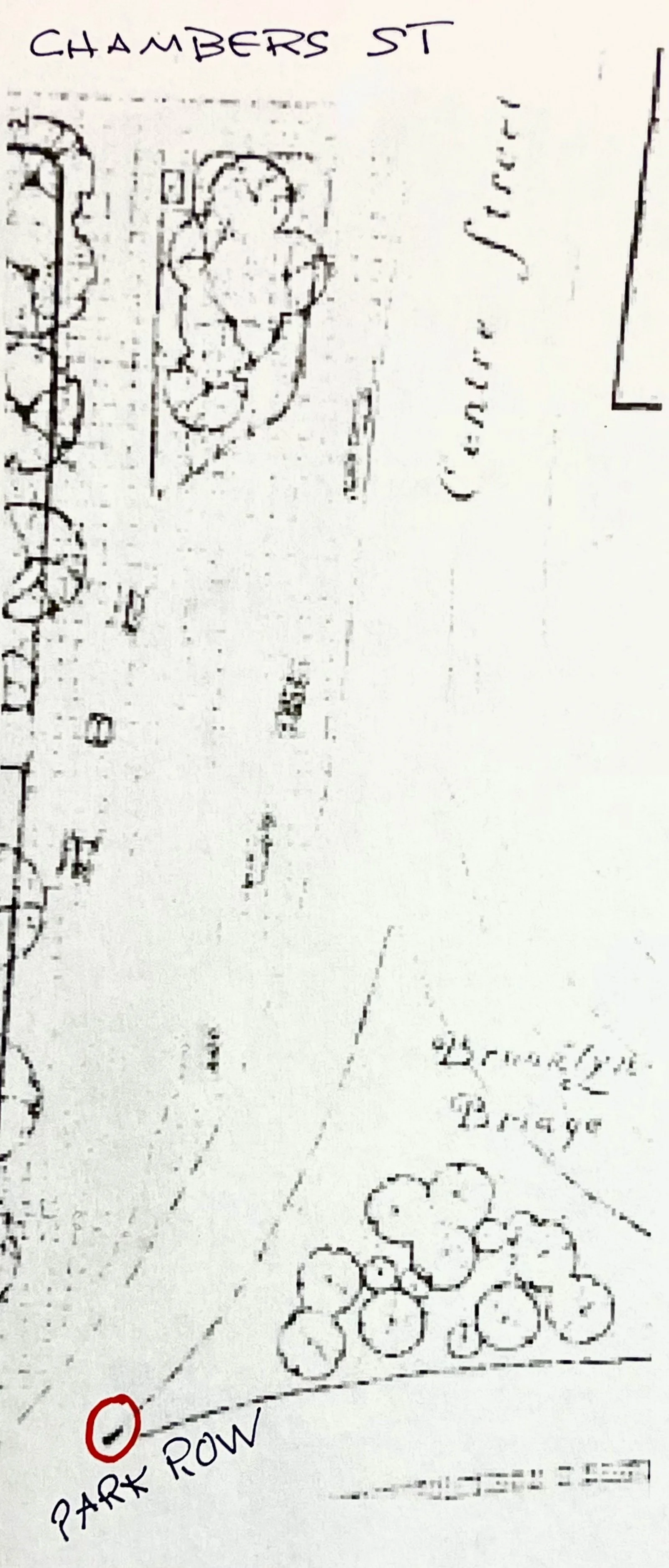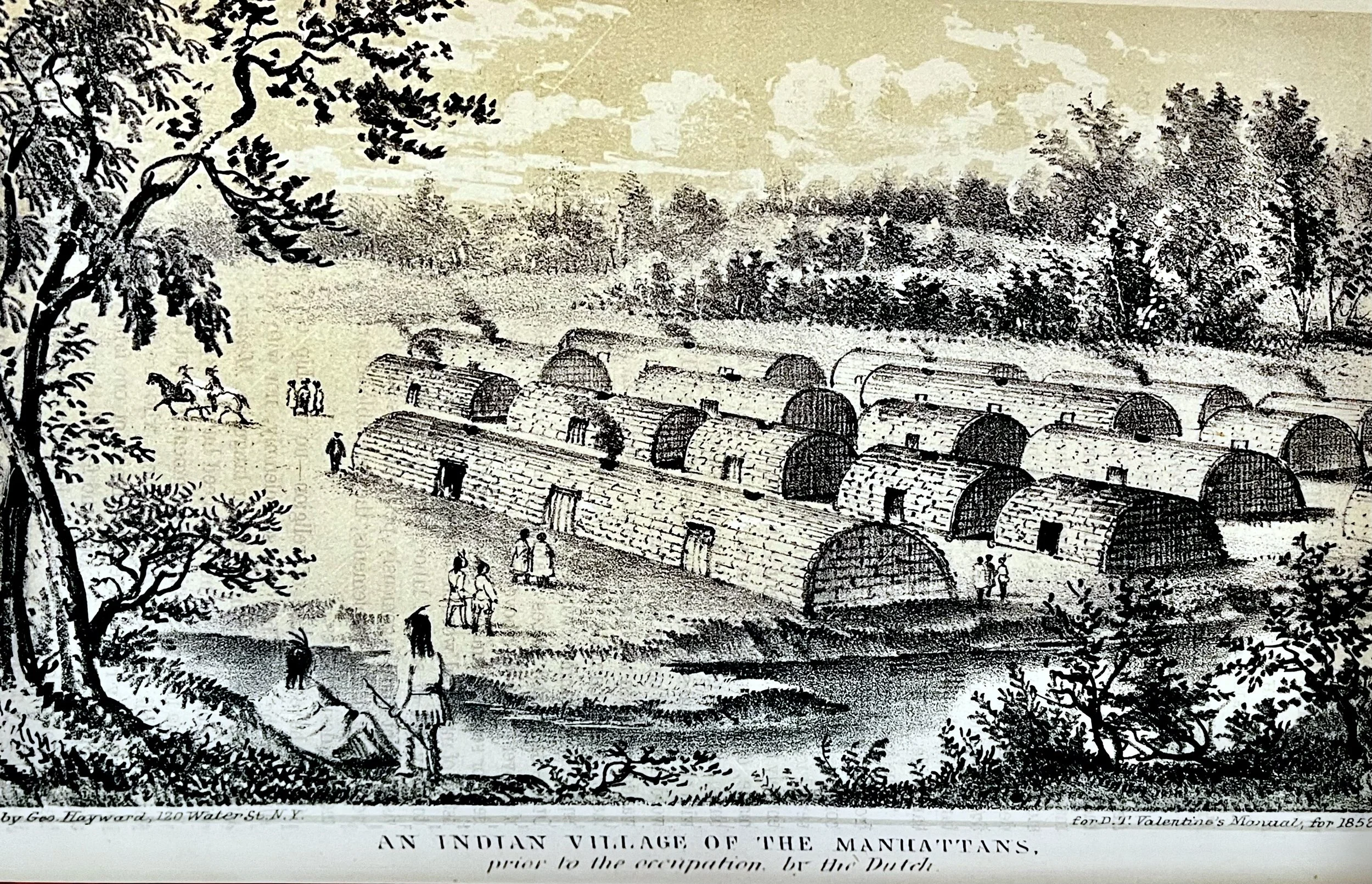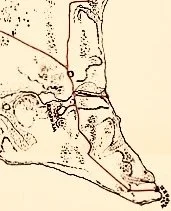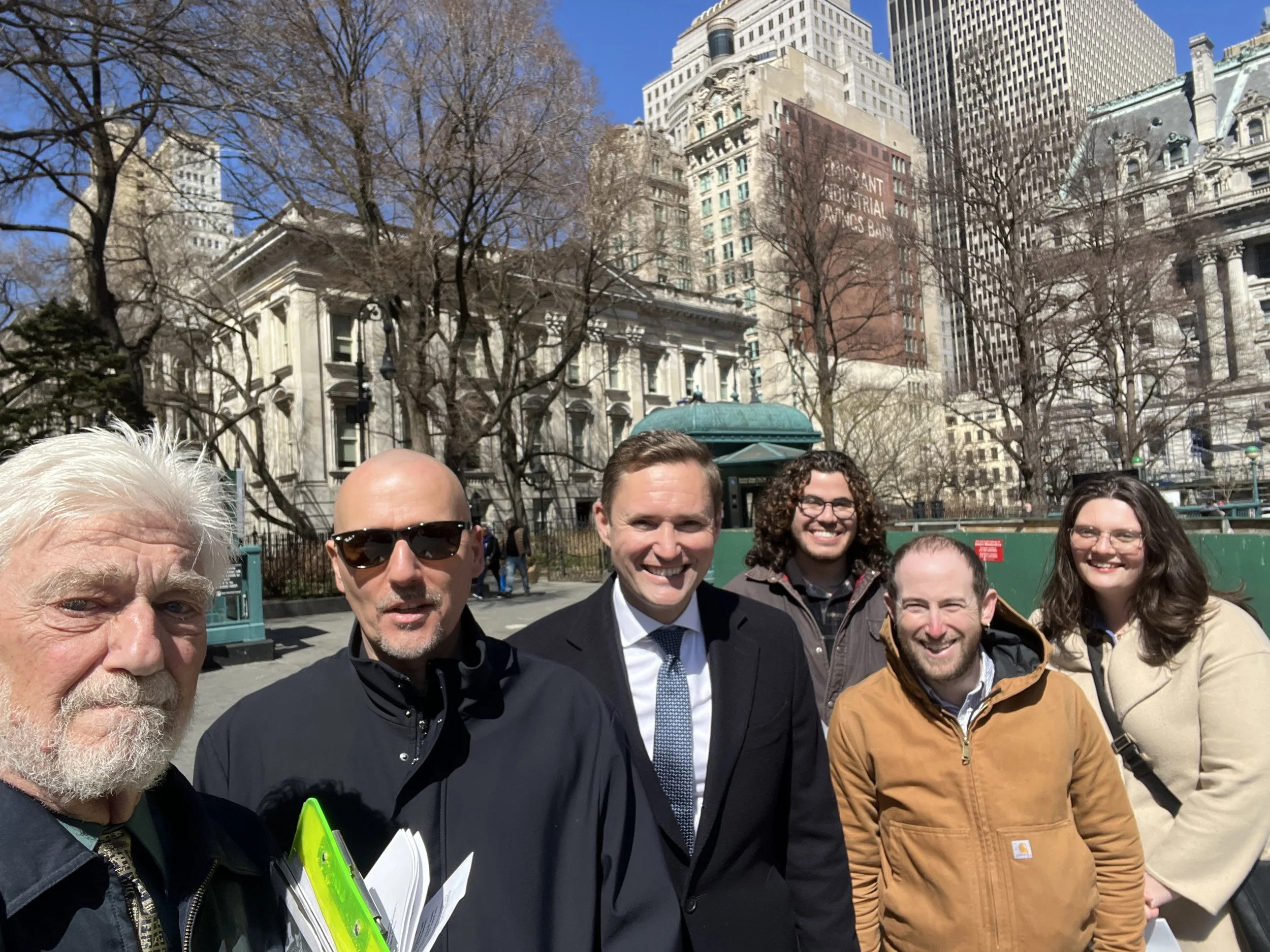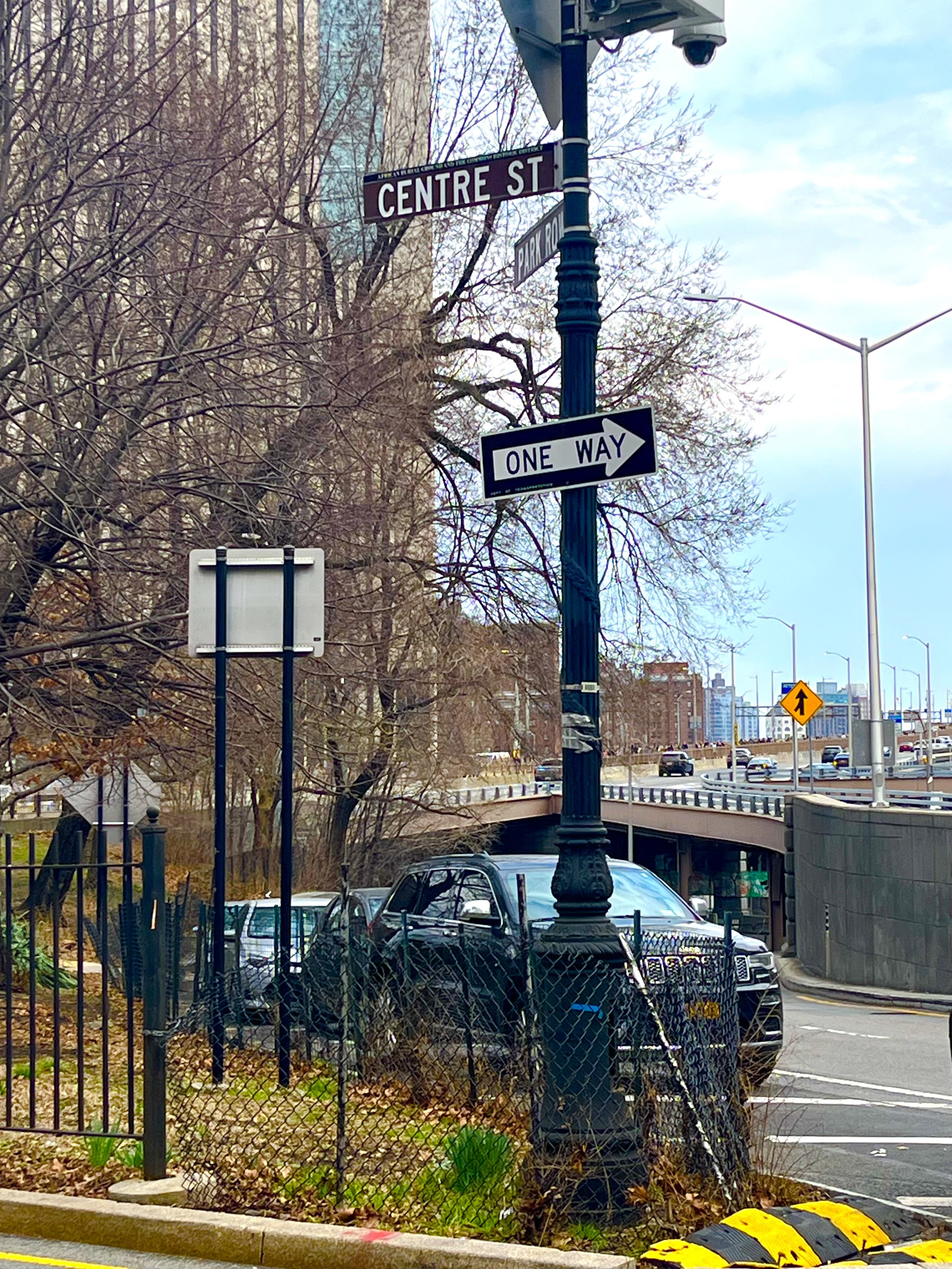CB1 Street Co-Naming Application
LENAPEHOKING Lenape Homeland Historic Place
Friends of City Hall Park in consultation with Lenape Center
Applicant’s Connection to Proposed Honoree: The Lenape are ancient geographic forebears for all of us in our neighborhood and in our city. FCHP recognizes the omission of the Lenape people in our civic center’s NYC historical signage, that, written in stone at the foot of the park, begins with the Dutch. This proposal by contemporary civic center neighbors, Friends of City Hall Park, in consultation with with Lenape Center, request that our Community Board and municipal government with this proposed DOT sign honor the first people, their modern descendants, and this place that is important in their and in our history, and currently, and offers a warm welcome back to their home.
Proposed Street Co-naming sign (circled in red) borders City Hall Park’s Northeast Plaza (site of future renovation Lenapehoking Plaza proposal):
Centre St & Park Row intersection. (
Scroll down for recent photos of pole.)
Manhattan Community Board 1’s jurisdiction district has been the homeland of the Lenape people for thousands of years, long before Dutch colonization four hundred years ago.
The Lenape homeland is culturally alive today for contemporary Lenape people, with Lenape Center’s office coincidently near CHP on Vesey Street. They are ancient geographic forebears for all of us in our neighborhood, in our city and in our region. Lower Manhattan, our civic center, was a centrally-located cross roads for the Lenape nation. From some perspectives, we all reside, work and play on Lenape land.
Lenapehoking, what the Lenape people call their historic region, translated as “Lenape homeland,” extends from the Hudson Valley to the Chesapeake Bay, with our civic center and CB1 near the center of Lenape territory.
Lenape families lived in a year-round village on a site that is now the open space of Federal Plaza, approximately from Worth Street to Duane Street.
Werpoes was one of innumerable Lenape villages over their thousands of years history on the shores of a 6-acre, 60-foot-deep, spring-fed fresh-water pond, with walking trails approximately where Centre St, Park Row and Broadway are now situated.
Lenape village (artist depiction) where Federal Plaza is now.
At the very beginning of colonization, the Lenape co-existed cooperatively with early settlers in the New Amsterdam village and in the nearby forest, including engaging in trade with the profit-seeking Dutch West India Company.
The sale of Manhattan island by the Lenape to the Dutch, a transaction with no evidence, is a profound cultural misunderstanding that continues today. In the first 40 years of colonization, historical documents report the genocide of 90% of the Lenape Nation population, as well as clear-cutting their villages, growing fields and forest habitat, then forced removal of the surviving Lenape to distant reservations by the early U.S. government. Historically, albeit with unused, more peaceful alternatives to the same end, the devastating eradication of the Lenape people and culture from this land locally and regionally allowed the European colonists to first build the center of the city’s and nation’s democracy in this place that developed into our metropolis.
Their predescendence in our neighborhood, before “recorded” history, and the symbolic recognition in our city government’s center make this available DOT pole in the site near City Hall best suited to honor the Lenape.
The proposed Street Co-naming honors the First People, their contemporary descendants, and this central place that is that is important in Lenape local and regional history, important in NYC’s local and regional history, and currently important to contemporary Lenape people and others who are pleased to work to offer well-deserved Lenape Homeland acknowledgement in our civic center.
It will specifically partially remedy omission in CHP’s NYC historical Time Wheel. It is a travesty that the NYC history written in stone in our civic center begins with the Dutch, ignoring the first people here, short of a reference to Broadway’s origins as a Lenape trail! Thousands of years of Lenape people here preceding Dutch arrival determines that City Hall Park’s Time Wheel slice of the history of this place starting in 1625 would indeed be very, very narrow compared to the twelve thousand prior years of Lenape history.
While the Lenape certainly played an important role in the early history of Lower Manhattan, the omission of their crucial role in shaping our city’s development and its government, and lack of recognition in civic center signage, is unique to this Application.
Among other contemporary contributions, the Lenape’s deep understanding of and devotion to the land and other natural elements can positively inspire and inform shaping of our city government and current city government issues today.
Fair compensation for the long-ago massacring and forcibly-taken land is not within the realm of this proposal, but this Proposed Street Co-naming historical acknowledgement of the place is fitting for NY’s civic center near City Hall that centuries ago was a centrally-located Lenape crossroads, with the same earth underneath the pavement on which the Lenape walked. CHP Northeast Plaza Renovation Proposal, with further Lenape acknowledgement in the plaza across Park Row from the proposed sign, will be submitted soon.
This proposed Street Co-naming in our civic center provides a substantial, permanent, culturally-important acknowledgement of the significance of Lenapehoking by Community Board 1 and then by our NYC government, as well as by other elected officials, and by neighborhood residents, City Hall Park Conservancy NYC, and other Friends of City Hall Park. It contributes to achieving the rightful historic position of the Lenape Nation.
In fact, recognizing the Lenape in City Hall Park's renovation plan is fitting. Their well-established presence and dominance in the area for many thousands of years, makes this location uniquely related to them (versus other groups who lived in the wider area), and offers a suggestion of more information for visitors who would like to learn more about the history and culture of the people being honored with a co-name sign.
This project has potential to make a profoundly positive, enriching, lasting, direct impact on the contemporary Lenape people, which sustains and nurtures their community traditions and identity, on our neighborhood, and on many of the thousands who will pass by the sign daily!
Lenape Center directors and cohort are respected, leading experts on Lenape history and culture, with frequent academic and cultural presentations, including as Visiting Professor at Colorado College and Columbia University.
Lenape Center’s Lenapehoking; An Anthology, (edited by Joe Baker, Hadrien Coumans & Joel Whitney, Brooklyn Public Library, 2023) is a powerful collection of well-written short essays and poems that tell the real story.
There are other well-received books covering the Lenape homeland that you might know, like The Island at the Center of the World (Russell Shorto, Vintage Books, 2006) and Mannahatta (Eric Sanderson, Illustrated by Markley Boyer, Abrams, 2009), many feature and documentary films and TV shows. Few are totally accurate; many are outrageously inaccurate.
This proposal is initiated by Friends of City Hall Park, 30-year-old community group of neighbors and NYers’ city-wide, who use and love our precious neighborhood park and all New Yorkers’ city commons; who volunteer to assist NYC Parks’ care for the 6 acres of publicly-accessible lawns and paths; who work with City Hall, NYPD and NYC Parks to assure and expand public access; and who lobby for adequate NYC Parks funding with the Play Fair coalition and for urban forest development city-wide with Forest for All NYC.
FCHP collaborates on achieving this proposal with Lenape Center’s Joe Baker, Executive Director and Hadrien Coumans, Deputy Director.
The Street Co-naming is proposed to be sponsored and supported by Mayor Eric Adams, Councilmember Chris Marte, NYS Senator Brian Kavanagh, NYS Assemblymember Deborah Glick, NY Congressmember Dan Goldman, Community Board 1 and City Hall Park Conservancy.
The project has been facilitated at NYC Parks by Regional Parks Manager Terese Flores, Park Gardener Brandon Grant, and Manhattan Commissioner Tricia Shimamura. Contact with DOT is Kate Scherer, DOT Lower Manhattan Planner.
~ ~ ~ ~ ~ ~ ~ ~ ~
Pole is exposed to thousands of pedestrians across the street daily.

